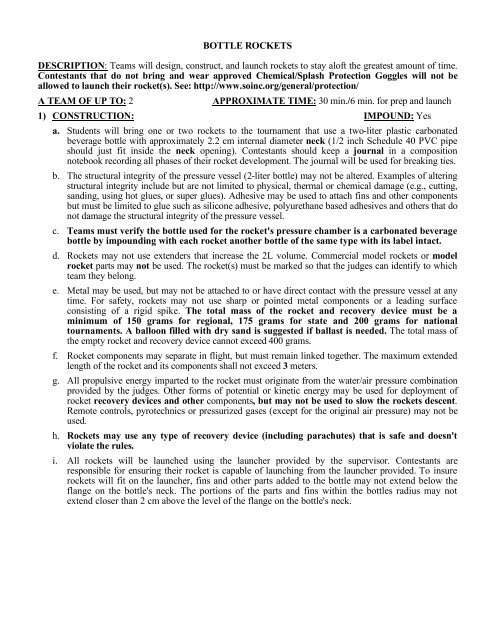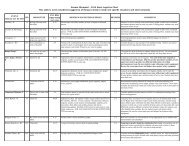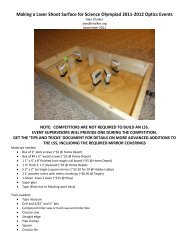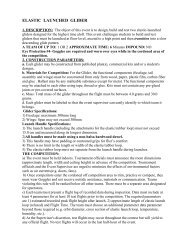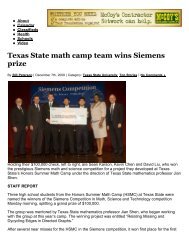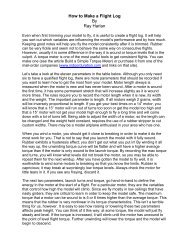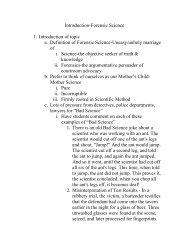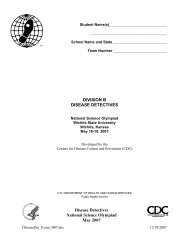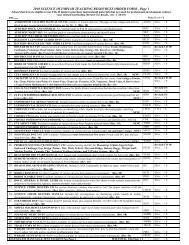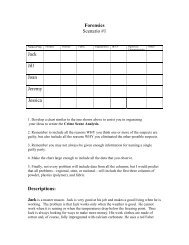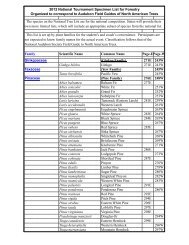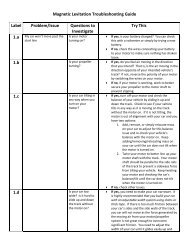Bottle Rocket - Science Olympiad
Bottle Rocket - Science Olympiad
Bottle Rocket - Science Olympiad
Create successful ePaper yourself
Turn your PDF publications into a flip-book with our unique Google optimized e-Paper software.
BOTTLE ROCKETS<br />
DESCRIPTION: Teams will design, construct, and launch rockets to stay aloft the greatest amount of time.<br />
Contestants that do not bring and wear approved Chemical/Splash Protection Goggles will not be<br />
allowed to launch their rocket(s). See: http://www.soinc.org/general/protection/<br />
A TEAM OF UP TO: 2<br />
APPROXIMATE TIME: 30 min./6 min. for prep and launch<br />
1) CONSTRUCTION: IMPOUND: Yes<br />
a. Students will bring one or two rockets to the tournament that use a two-liter plastic carbonated<br />
beverage bottle with approximately 2.2 cm internal diameter neck (1/2 inch Schedule 40 PVC pipe<br />
should just fit inside the neck opening). Contestants should keep a journal in a composition<br />
notebook recording all phases of their rocket development. The journal will be used for breaking ties.<br />
b. The structural integrity of the pressure vessel (2-liter bottle) may not be altered. Examples of altering<br />
structural integrity include but are not limited to physical, thermal or chemical damage (e.g., cutting,<br />
sanding, using hot glues, or super glues). Adhesive may be used to attach fins and other components<br />
but must be limited to glue such as silicone adhesive, polyurethane based adhesives and others that do<br />
not damage the structural integrity of the pressure vessel.<br />
c. Teams must verify the bottle used for the rocket's pressure chamber is a carbonated beverage<br />
bottle by impounding with each rocket another bottle of the same type with its label intact.<br />
d. <strong>Rocket</strong>s may not use extenders that increase the 2L volume. Commercial model rockets or model<br />
rocket parts may not be used. The rocket(s) must be marked so that the judges can identify to which<br />
team they belong.<br />
e. Metal may be used, but may not be attached to or have direct contact with the pressure vessel at any<br />
time. For safety, rockets may not use sharp or pointed metal components or a leading surface<br />
consisting of a rigid spike. The total mass of the rocket and recovery device must be a<br />
minimum of 150 grams for regional, 175 grams for state and 200 grams for national<br />
tournaments. A balloon filled with dry sand is suggested if ballast is needed. The total mass of<br />
the empty rocket and recovery device cannot exceed 400 grams.<br />
f. <strong>Rocket</strong> components may separate in flight, but must remain linked together. The maximum extended<br />
length of the rocket and its components shall not exceed 3 meters.<br />
g. All propulsive energy imparted to the rocket must originate from the water/air pressure combination<br />
provided by the judges. Other forms of potential or kinetic energy may be used for deployment of<br />
rocket recovery devices and other components, but may not be used to slow the rockets descent.<br />
Remote controls, pyrotechnics or pressurized gases (except for the original air pressure) may not be<br />
used.<br />
h. <strong>Rocket</strong>s may use any type of recovery device (including parachutes) that is safe and doesn't<br />
violate the rules.<br />
i. All rockets will be launched using the launcher provided by the supervisor. Contestants are<br />
responsible for ensuring their rocket is capable of launching from the launcher provided. To insure<br />
rockets will fit on the launcher, fins and other parts added to the bottle may not extend below the<br />
flange on the bottle's neck. The portions of the parts and fins within the bottles radius may not<br />
extend closer than 2 cm above the level of the flange on the bottle's neck.
2) THE COMPETITION:<br />
a. All rockets must be impounded before the start of the competition and will be released after the last<br />
team has finished competing. Once impounded, no physical alterations may be made to the rocket.<br />
Appeals by teams will not be processed after they remove their device from impound unless it has<br />
been released by the appeals committee.<br />
b. Once teams enter the event area to compete, they may not leave the area or receive outside<br />
assistance, materials or communication until they have finished competing. Only contestants<br />
and judges will be allowed in the event area while teams are competing. Teams violating this<br />
rule will be disqualified.<br />
c. When it's their turn, contestants will pick up their rockets and proceed to the designated staging area<br />
to prepare their recovery system. After a safety inspection, the contestants will be allowed six minutes<br />
to prepare and launch their rocket(s). The six-minute time will include adjustments to the rockets,<br />
adding water, launch of both rockets and timing of the first flight. Contestants will not be allowed to<br />
add water and launch their rockets without approved eye protection.<br />
d. Teams may not shield their rocket from the wind while on the launcher.<br />
e. All rockets will be launched at a pressure requested by the competitors, not to exceed 60 pounds per<br />
square inch. Once the rocket is pressurized, contestant may not touch or approach the rocket.<br />
f. Timing of the rocket stops when the first part of the rocket hits a stationary object (ground,<br />
building, tree, etc.) or when the rocket disappears from the judge’s sight. All rocket launch times<br />
will be recorded to the nearest hundredth of a second. Preferably three timers should be used and the<br />
middle time should be recorded.<br />
g. Only one launch is allowed per rocket. Any rocket launched before the time expires will be scored.<br />
h. Each team will be asked to explain an entry in their journal randomly chosen by the judges.<br />
SCORING:<br />
a. All rocket launch times will be recorded to the nearest hundredth of a second. A team’s score will be<br />
the flight time of the rocket that gives them the higher rank. The greater flight time wins.<br />
b. <strong>Rocket</strong>s whose parts do not remain linked while aloft will be ranked by their flight time in a second<br />
tier after those that remain linked.<br />
c. <strong>Rocket</strong>s that violate any rule that doesn't have a specific penalty will be ranked in a third tier by<br />
their flight time.<br />
d. Teams that attempt to participate but are unable to launch at least one rocket for any reason<br />
will receive participation point(s) only (e.g., participants did not have eye protection, rockets<br />
failed safety inspection or rocket would not fit on launcher).<br />
e. When teams that launched two rockets each are tied, the winner will be the team with the longer time<br />
aloft of the shorter flight. Teams that launched two rockets will win ties over teams that launched<br />
only one rocket. Remaining ties will be broken using the team’s journal and their explanation of<br />
the entry chosen by the judges.<br />
Copyright © <strong>Science</strong> <strong>Olympiad</strong>


